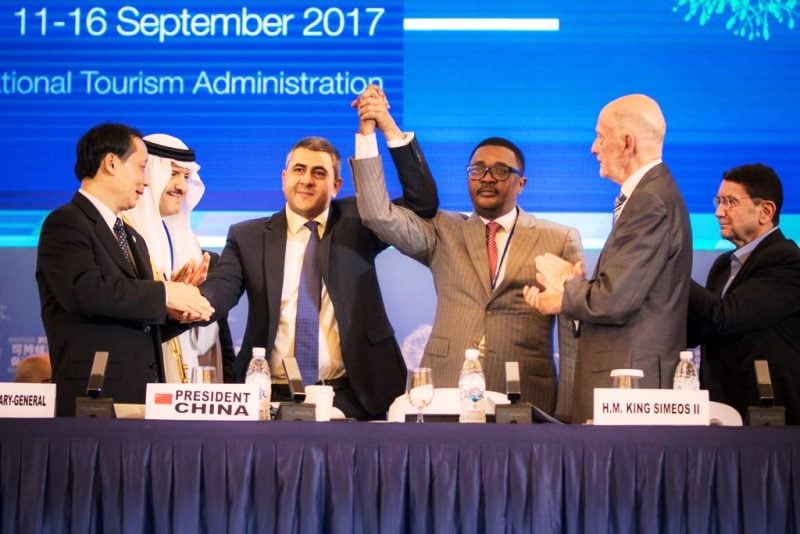ISLAMABAD, Pakistan (eTN) – The Chairman of the Iranian parliament, Mr. Ali Larijani, in his meeting with the Senate Chairman of Pakistan, Mr. Nayar Bukhari, has confirmed that the Iran-Pakistan-India Pipeline (IPI) pipeline project will be completed within its schedule time, and maintained that despite the criticism of international forces, both countries are to keep working on this important project.
According to a statement issued by the office of Senate Chairman of Pakistan, both leaders had a meeting in Tehran, and both also discussed plans for a bi-lateral visit of parliamentarians from both countries.
The United States has loudly criticized the IPI project and supporting Turkmenistan-Afghanistan-Pakistan-India (TAPI) gas pipeline, while Pakistan decided to work on both projects, as experts believe that TAPI is financially an unstable and unviable project, while IPI can be a success. However, Pakistan apparently does not want to annoy the United States, therefore, it will also keep working on TAPI.
IPI does not touch any troubled areas, including a safe passage from Baluchistan, because according to the proposed design, the pipeline shall be constructed on-shore from the delivery point at the Pakistan-Iran border to the point at which the gas is injected into the national gas transmission system in Pakistan (Nawabshah).
The pipeline will connect Iran’s giant South Fars gas field with Pakistan’s Baluchistan and Sindh provinces.
Pakistan will construct about an 800-km long pipeline from its border, passing through the Mekran Coastal Highway to connect with its existing gas transmission network at Nawabshah. Iran has almost finished a 300-km-long stretch from Iranshahr to Pakistan’s border through the Iranian port of Chabahar.
On completion, 5,000 megawatts of electricity will be generated through this gas, which is equivalent to the peak shortage of power at present.
In February 2012, the Russian government asked Pakistan to award a piece of the project worth $1.2 billion of the pipeline-laying contract of the Iran-Pakistan-India Gas Pipeline to its energy giant, Gazprom, and without going into a bidding process, IPI is a much quicker solution and more secure. TAPI would mainly pass through Afghanistan, however, securing a large diameter pipeline may be an issue. The completion time of TAPI is much longer than IPI, with no investor in sight.
Whether IPI or TAPI will become reality for Pakistan remains questionable, with the answer not to come from Pakistan or India, but rather from with investors.
Turkmenistan, Afghanistan, Pakistan, and India formally agreed to build the pipeline, which is set to supply some 30 billion cubic meters per year of Turkmen natural gas to India, but no international consortium has guaranteed investment in the project, although the United States is putting its full weight behind the project to make it a reality in order to ensure a regular income of around US$400 million to Afghanistan per year by way of a “transit” fee.
The Afghan government has ensured partners to assign as many as 12,000 Afghan security personnel to safeguard the security of the TAPI project. Kandahar and Herat provinces will be the main provinces impacted by the TAPI pipeline, which is expected to cover 735 km of Afghanistan. This insurance indicates how risky this gas pipeline route is, where one suicide bomber can explode himself resulting in a disruption of the gas supply. How a 735-km-long pipeline can be saved from expected well-coordinated suicide bomber attacks in this area, is the biggest question that nobody has been able to satisfactorily answer to international investors.
The pipeline will run 144 km in Turkmenistan, 735 km into Afghanistan, and 800 km in Pakistan, before reaching India and will have a capacity to transport 90 mscmd of gas – 38 mscmd each for India and Pakistan, and the remaining 14 mscmd for Afghanistan.
Now in September, the Asian Development Bank, United States of America, and all four countries involved, will place the project in a showcase to the United Kingdom to attract investors. One of interested parties in the past, the Russian national company Gazprom, is now lacking interest in the project, while it is ready to invest instantly in the Iran-Pakistan-India (IPI) Pipeline project. IPI looks very viable for energy-starved Pakistan, as this pipeline has already reached and is ready to operate at the Pakistan-Iran border, and its route is trouble free. However, constant and tremendous pressure from the USA against Iran is the biggest hurdle in realizing this project. It looks like Pakistan does not want to withdraw from IPI unless TAPI gets funding and its execution is 100 percent confirmed.
During the Shanghai Cooperation Organization (SCO) summit, the President of Pakistan, Asif Ali Zardari, discussed the IPI project with the Iranian President, and the two sides have agreed to urgently resolve the issue of credit for the Iran-Pakistan gas pipeline, so as to complete the project expeditiously. According to reports, Pakistan emphasized the need for an early completion of projects, including IPI and the electricity project.
Sources indicate that Mr. Zardari, during his meetings at Shanghai, talked about this project at length and was of the view that Pakistan will keep working on IPI despite US pressures.
The United States considers the Turkmenistan-Afghanistan-Pakistan-India project the most important to stabilize Afghanistan in post-NATO withdrawal from Afghanistan. The project is a part of a US-sponsored New Silk Road project. The route of this pipeline is through the Hot Bed of Afghanistan – Herat and Kandahar provinces – that have constantly been under the control of the Taliban even during the full presence of NATO forces. One can understand how much these areas could be under the control of the Taliban once international forces are withdrawn. Indian experts are of the view that TAPI can only be possible if it is underground, but that will increase the cost of the project from an estimated US$7.6 billion to an estimated US$12 billion, because the underground pipeline will be laid in a concrete tunnel.
The instability in Afghanistan and in the Baluchistan areas of Pakistan is complicating the implementation of the Turkmenistan-Afghanistan-Pakistan-India project.
The Russian National Energy Institute (RNEI), in its latest report, suggested that the Russian government should refrain from investing in this project. The Director General of RNEI, Mr. Pravosudov, is of the view that two controversial points that relate to the issue of security still remain in this issue, and it is still a big question as to how realistic it is that this project will be implemented. In both cases, he said, the situation is not very favorable for the implementation of large investment projects like TAPI. The Russian National Energy Institute is of the view that until security issue is resolved, the parties will not begin construction of the pipeline, and the issue, according to the expert, is unlikely to be resolved in the near future.
Turkmenistan is selling gas to Russia, China, and Iran. Not a single pipeline of these projects goes through Afghanistan, therefore, no security cost is involved and prices are lesser than the proposed TAPI project. In May 2012, China and Turkmenistan agreed to increase Turkmen natural gas exports. China National Petroleum Corp (CNPC), builder and operator of the lengthy East-West Gas Pipeline (EWGP), signed the deal with Turkmenistan’s state-run energy major Turkmengaz to buy 65 billion cubic meters (bcm) of Turkmen gas per year. CNPC said the two companies had pumped a total of 30 billion cubic meters of gas from Turkmenistan since the transnational pipeline was inaugurated in 2009.
Chinese imports surged three-fold in 2011 over the previous year. China is expected to double its current gas consumption in the coming five years. The International Energy Agency has forecasted that China will consume one-quarter of the world’s demand for gas over the coming five-year period.
This development has softened the enthusiasm of Turkmenistan in TAPI, because China has ensured Turkmenistan that its demand will constantly increase in the next 5 years. The Turkmenistan-China pipeline is a trouble-free route and fully operational, while the TAPI project is yet to receive funding and will go through instable Afghanistan. The Turkmenistan-China pipeline is about 1,833 kilometers (1,139 miles) long, of which 188 kilometers (117 miles) are in Turkmenistan and 530 kilometers (330 miles) are in Uzbekistan. The diameter of the pipeline is 1,067 millimeters (42.0 inches). The first stage of the pipeline was completed in 2009.
The pipeline starts in Saman-Depe, carrying natural gas from the Bagtyyarlyk gas fields on the right bank of Amu Darya in Turkmenistan. It is mainly supplied from Iolotan and Sag Kenar fields. The pipeline enters Uzbekistan in Olot and runs across Uzbekistan to southern Kazakhstan, parallel to the existing Bukhara-Tashkent-Bishkek-Almaty pipeline. The pipeline crosses the Kazakhstan-China border at Khorgos, where it is connected to the second West-East Gas Pipeline.
The TAPI project was actually signed in late 2010 as an economic package to Afghanistan and as a part of a US-sponsored New Silk Road project, although this project has been under consideration for decades. The design capacity of the pipeline is up to 33 billion cubic meters of gas per year. The project is promoted by the Asian Development Bank.
The resource base, in addition to the Dovletabad field, is the largest field in Turkmenistan, namely the Southern Yoloten-Osman (Galkynysh). At present the principle of forming an international consortium is being discussed. Turkmen state-controlled gas major, Turkmengas, inked the sales and purchase agreements with India’s state gas company, GAIL, and Pakistan’s Inter State Gas Systems on May 23, 2012 at the Caspian resort, Avaza of Turkmanistan, and just 3 days after the Turkmen President Gurbanguly Berdimuhamedov fired his Minister of Oil, Gas, and Mineral Resources, Bayramgeldi Nedirov, who signed this agreement. The Minister was dismissed for alleged serious shortcomings in his work. Mr. Nedirov is the fifth oil and gas chief to be fired by the President.
The outgoing official was immediately replaced by Kakageldi Abdyllaev, who served as Deputy Chairman of state-controlled oil and gas company. This new development has also shaken the confidence of potential investors of the TAPI project, because the situation again indicated that the Turkmenistan energy sector, that is the main actor in TAPI, is still under the grip of uncertainty, as the President of Turkmanistan, Mr. Berdimuhamedov, also sacked the other four energy heads for incompetence during the last 5 years. International consortiums usually avoid such projects that have a turbulent political history, as well as security concerns, and both of these negative factors are very much present in the TAPI project.
The roadshow of TAPI, which will invite players to participate in the project, is expected to kick off in September 2012. In the TAPI project, which has US backing, big American companies such as Chevron and ExxonMobil, are said to be interested in becoming part of the consortium. Investors, including Overseas Private Investment Corporation (OPIC) and Export-Import Bank (EIB), are in the contact of the Asian Development Bank.
The decision with regard to the consortium will be made jointly by member-countries in consultation with the Asian Development Bank (ADB), which will render technical advice with regard to the terms and conditions for potential consortium partners. The ADB will also be involved in the final selection process.
The pipeline is expected to be operational in 2018 if it gets investors in by year 2012. Member-countries of the TAPI project have agreed to a uniform transit fee of 49.5 cents. The transit fee paid is also for the security of the network from where the pipeline is passing.
The transit fee is a crucial issue in such projects, as invariably the country at the tail-end of the project ends up paying the most. The transportation charges will be finalized when the project gets implemented by the consortium nominated and all costs are known. India would like the delivered price (landed cost) of Turkmenistan gas to be in the same range for all buyer countries – Afghanistan, Pakistan, and India. India also wanted the Turkmenistan gas price to be more attractive than the current long-term contract price. Rough estimates show that the Turkmenistan gas may cost around $13/mBtu to India.
(eTN): Iran and Pakistan keep working on IPI gas pipeline project | re-post license | post content






















